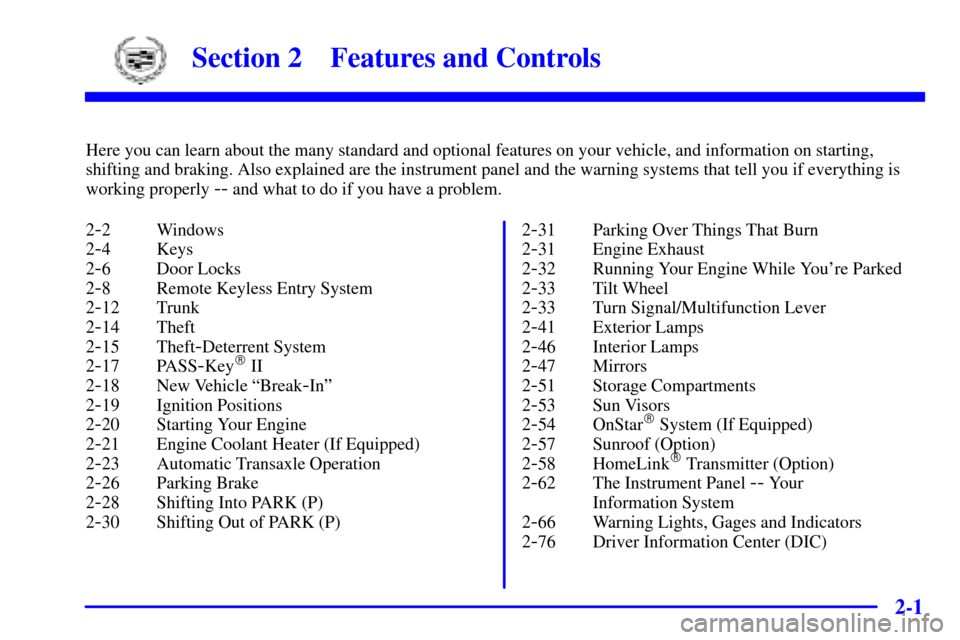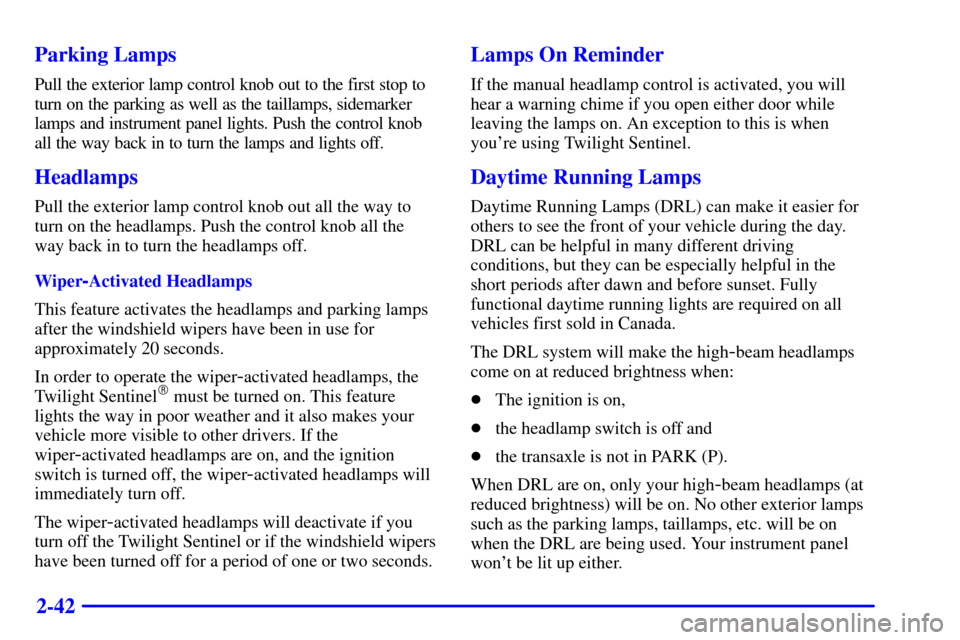Page 4 of 335
ii
Table of Contents
Windows
Keys and Door Locks
Remote Keyless Entry System
Trunk Release
Automatic Transaxle
Parking Brake
Tilt Wheel
Turn Signal/Multifunction Lever
Windshield Wipers
Cruise Control
Exterior and Interior LampsMirrors
Storage Compartments
Convenience Net
Accessory Power Outlets
OnStar® System (If Equipped)
Sunroof (Option)
HomeLink® Transmitter (Option)
Instrument Panel, Warning Lights and Gages
Driver Information Center
Memory and Personalization Features (If Equipped) Seats and Seat Controls
Safety BeltsAir Bag Systems
Restraint Systems for Children
Section
1
Section
2
Seats and Restraint Systems
Features and Controls
Page 5 of 335
Section
3
Comfort Controls and Audio Systems
Section
4
Your Driving and the Road
Section
5
Table of Contents (cont'd)
Defensive Driving
Drunken Driving
Control of a Vehicle
BrakingSteering
Driving Tips for Various Road Conditions
Loading Your Vehicle
Towing a Trailer Heating and Air Conditioning
Setting the Radio Clock
Radio/Cassette Player/CD Player (If Equipped)Radio Theft-Deterrent Feature
Steering Wheel Controls
Hazard Warning Flashers
Jump Starting
Towing Your VehicleEngine Overheating
Changing a Flat Tire
If You're Stuck
Problems on the Road
iii
Page 10 of 335
viii
Vehicle Damage Warnings
Also, in this book you will find these notices:
NOTICE:
These mean there is something that could
damage your vehicle.
In the notice area, we tell you about something that can
damage your vehicle. Many times, this damage would
not be covered by your warranty, and it could be costly.
But the notice will tell you what to do to help avoid
the damage.
When you read other manuals, you might see CAUTION
and NOTICE warnings in different colors or in
different words.
You'll also see warning labels on your vehicle. They use
the same words, CAUTION or NOTICE.
Page 11 of 335

ix
For example,
these symbols
are used on an
original battery:
CAUTION
POSSIBLE
INJURY
PROTECT
EYES BY
SHIELDING
CAUSTIC
BATTERY
ACID COULD
CAUSE
BURNS
AVOID
SPARKS OR
FLAMES
SPARK OR
FLAME
COULD
EXPLODE
BATTERY
These symbols
are important for
you and your
passengers
whenever your
vehicle is driven:
CHILD
RESTRAINT
TOP STRAP
ANCHOR
DOOR LOCK
UNLOCK
FASTEN
SEAT
BELTS
POWER
WINDOW
AIR BAG
These symbols
have to do with
your lamps:
MASTER
LIGHTING
SWITCH
TURN
SIGNALS
PARKING
LAMPS
HAZARD
WARNING
FLASHER
DAYTIME
RUNNING
LAMPS
FOG LAMPS
These symbols
are on some of
your controls:
WINDSHIELD
WIPER
WINDSHIELD
WASHER
WINDSHIELD
DEFROSTER
REAR
WINDOW
DEFOGGER
VENTILATING
FAN
These symbols
are used on
warning and
indicator lights:
ENGINE
COOLANT
TEMP
BATTERY
CHARGING
SYSTEM
BRAKE
COOLANT
ENGINE OIL
PRESSURE
ANTI-LOCK
BRAKES
Here are some
other symbols
you may see:
FUSE
LIGHTER
HORN
FUEL
Vehicle Symbols
These are some of the symbols you may find on your vehicle. Also see ªWarning Lights and Gagesº in the Index.
Page 62 of 335

2-
2-1
Section 2 Features and Controls
Here you can learn about the many standard and optional features on your vehicle, and information on starting,
shifting and braking. Also explained are the instrument panel and the warning systems that tell you if everything is
working properly
-- and what to do if you have a problem.
2
-2 Windows
2
-4 Keys
2
-6 Door Locks
2
-8 Remote Keyless Entry System
2
-12 Trunk
2
-14 Theft
2
-15 Theft-Deterrent System
2
-17 PASS-Key� II
2
-18 New Vehicle ªBreak-Inº
2
-19 Ignition Positions
2
-20 Starting Your Engine
2
-21 Engine Coolant Heater (If Equipped)
2
-23 Automatic Transaxle Operation
2
-26 Parking Brake
2
-28 Shifting Into PARK (P)
2
-30 Shifting Out of PARK (P)2
-31 Parking Over Things That Burn
2
-31 Engine Exhaust
2
-32 Running Your Engine While You're Parked
2
-33 Tilt Wheel
2
-33 Turn Signal/Multifunction Lever
2
-41 Exterior Lamps
2
-46 Interior Lamps
2
-47 Mirrors
2
-51 Storage Compartments
2
-53 Sun Visors
2
-54 OnStar� System (If Equipped)
2
-57 Sunroof (Option)
2
-58 HomeLink� Transmitter (Option)
2
-62 The Instrument Panel -- Your
Information System
2
-66 Warning Lights, Gages and Indicators
2
-76 Driver Information Center (DIC)
Page 88 of 335

2-27
If the parking brake has not been fully released and
you try to drive with the parking brake on, the
BRAKE indicator light comes on and stays on.
See ªBrake System Warning Lightº in the Index for
more information.
When you move out of PARK (P) or NEUTRAL (N),
if the engine is running, the parking brake should
release. If it doesn't, you can manually release the
parking brake.
CAUTION:
Always shift to PARK (P) before pulling the
manual release lever. If your hand or arm is in
the way of the pedal you could be hurt. The pedal
springs back quickly. Keep your hand and arm
away when you use the manual release lever.
Be sure to turn off the ignition and put the vehicle in
PARK (P) before manually releasing the brake.
Reach under the driver's side of the instrument panel
and pull on the manual release lever, which is located
above the parking brake pedal. If the parking brake does
not release, you should either drive to the nearest service
station or have your vehicle towed.
Page 95 of 335

2-34 Turn and Lane Change Signals
To signal a turn, move the lever all the way up or
down. The lever returns automatically when the turn
is complete.
An arrow located on the
instrument panel cluster will
flash in the direction of the
turn or lane change.
Raise or lower the lever until the arrow starts to flash to
signal a lane change. Hold it there until the lane change
is complete. The lever returns when it's released.
If the turn signal is left on, a warning chime will sound
and the Driver Information Center (DIC) will display
TURN SIGNAL ON (after driving about 1 mile
(1.6 km/h)) to remind you to turn it off.Arrows that flash rapidly when signaling for a turn or
lane change may be caused by a burned
-out signal bulb.
Other drivers won't see the turn signal.
Replace burned
-out bulbs to help avoid possible
accidents. Check the fuse (see ªFuses and Circuit
Breakersº in the Index) and for burned
-out bulbs if the
arrow fails to work when signaling a turn.
Headlamp High/Low Beam Changer
This light located on the
instrument panel panel will
be on when the high beam
headlamps are in use.
Pull the turn signal lever all the way toward you and
then release it to change the headlamps from low beam
to high or from high beam to low.
Page 103 of 335

2-42 Parking Lamps
Pull the exterior lamp control knob out to the first stop to
turn on the parking as well as the taillamps, sidemarker
lamps and instrument panel lights. Push the control knob
all the way back in to turn the lamps and lights off.
Headlamps
Pull the exterior lamp control knob out all the way to
turn on the headlamps. Push the control knob all the
way back in to turn the headlamps off.
Wiper
-Activated Headlamps
This feature activates the headlamps and parking lamps
after the windshield wipers have been in use for
approximately 20 seconds.
In order to operate the wiper
-activated headlamps, the
Twilight Sentinel� must be turned on. This feature
lights the way in poor weather and it also makes your
vehicle more visible to other drivers. If the
wiper
-activated headlamps are on, and the ignition
switch is turned off, the wiper
-activated headlamps will
immediately turn off.
The wiper
-activated headlamps will deactivate if you
turn off the Twilight Sentinel or if the windshield wipers
have been turned off for a period of one or two seconds.
Lamps On Reminder
If the manual headlamp control is activated, you will
hear a warning chime if you open either door while
leaving the lamps on. An exception to this is when
you're using Twilight Sentinel.
Daytime Running Lamps
Daytime Running Lamps (DRL) can make it easier for
others to see the front of your vehicle during the day.
DRL can be helpful in many different driving
conditions, but they can be especially helpful in the
short periods after dawn and before sunset. Fully
functional daytime running lights are required on all
vehicles first sold in Canada.
The DRL system will make the high
-beam headlamps
come on at reduced brightness when:
�The ignition is on,
�the headlamp switch is off and
�the transaxle is not in PARK (P).
When DRL are on, only your high
-beam headlamps (at
reduced brightness) will be on. No other exterior lamps
such as the parking lamps, taillamps, etc. will be on
when the DRL are being used. Your instrument panel
won't be lit up either.